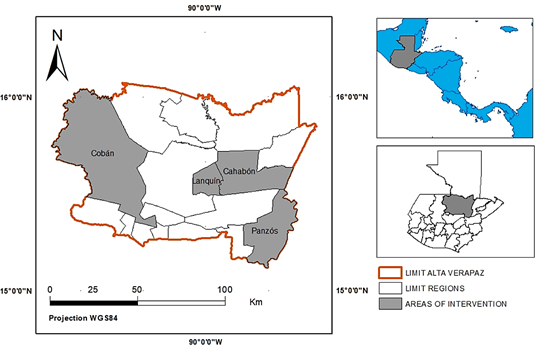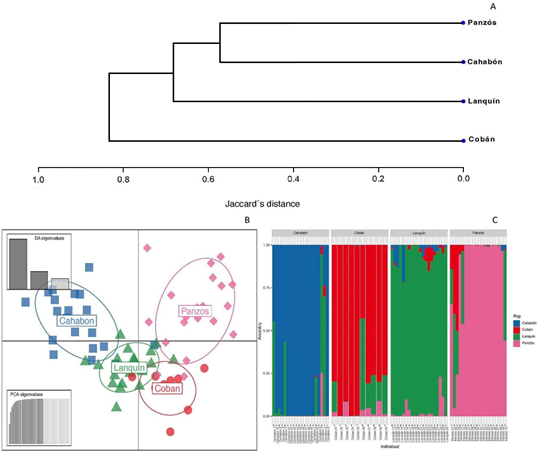1. Introduction
Cocoa (Theobroma cacao L.) is currently a burgeoning crop at a global scale (Barrezueta-Unda & Paz-González, 2018; Carvalho et al., 2023; Palacios & Bokelmann, 2017). Worldwide, approximately 12 million ha of land is under cocoa production (Niether et al., 2020), representing one of the most important cash crops in humid tropics, especially for smallholder farmers (Tscharntke et al., 2022). Around 70% of the world’s cocoa is grown alongside shade trees, as well as annual and perennial crops (Matey et al., 2013). Cocoa is usually cultivated by smallholder farmers in tropical regions (Braga et al., 2019) and when agroforestry practices are used, these can mimic structural and functional elements of a natural forest (Mcneely & Schroth, 2006; Vebrova et al., 2014). In Latin America, about 350,000 families practice cocoa farming and at least 1.7 million rely on cocoa production (Instituto Nacional de Investigaciones Agropecuarias [INIAP], 2019). According to Sol-Sánchez et al. (2018), in Latin America, cocoa cultivation has been established under the shade of tree species remaining from the natural forest, which, sometimes, does not represent an economic value for the producers, but it has high ecological value.
Agroforestry (AF) is widely considered an alternative to conventional agriculture that provides greater productive and ecological benefits, such as: functional diversity improvement (Abada Mbolo et al., 2016; Ambele et al., 2023; Navarro et al., 2012); carbon sequestration (Ma et al., 2020; Manaye et al., 2021); food administration, wood and fuel (Pocomucha et al., 2016; Soler et al., 2012; Suárez-Venero et al., 2019) and their contribution to micro-climate (Shah et al., 2021) among other things. The structure and composition of traditional AFS is determined by the cultural heritage of the growers and the application of management practices during the production cycle (Chablé-Pascual et al., 2015; Cotta, 2017). In the last decades there has been a constant growth in the number of studies about the potential for biodiversity conservation in the AFSs of shade-grown cacao (Delgado-Vargas et al., 2022; Morán-Villa et al., 2022; Sonwa et al., 2017). The results demonstrate that AFSs with a diverse canopy of shade trees have a greater potential for biodiversity conservation as compared to plantations with a simplified shade canopy or monocultures of cocoa (Braga et al., 2019; Méndez et al., 2013; Sánchez Gutierrez et al., 2016)
The socioeconomic and ecological importance of these systems is being recognized by the scientific community around the world. In Mexico, Zequeira-Larios et al. (2021) demonstrated that the practices of management employed by smallholder cocoa growers have enabled the conservation function of these AFSs, as well as strengthening their own food security and increasing their income through the variety of other products cultivated in these systems. In Uganda, Bukomeko et al. (2019), found that the AFSs had the capacity to conserve a high level of biodiversity of tree species that provide important ecological services, while in Ecuador, the complex structure of the CAFSs contributes to the preservation of native and endangered species and reduces the degradation of forests and soils (Vera-Vélez et al., 2019).
Guatemala is a country with a high percentage of population living in rural areas, of which around 59 % live in conditions of poverty (INE, 2018). Two thirds of this population depend on agriculture and silviculture as their main livelihood (Nicli et al., 2019). Notwithstanding, intensive agriculture as an economic activity is one of the main threats that has deteriorated the forest resource and the biodiversity that is protected in them, since the population has seen the need to replace the forest for various uses and consequently, the satis faction of basic needs (Pineda, 2022). According to Bullock et al. (2020) the total deforested area in Guatemala between 2000 and 2017 was around 854,137 ha of forest. Studies by various national in stitutions have shown that the main causes of biodiversity loss in Guatemala are non-integrated management of biodiversity, unsustainable use of the land, undervaluation of biodiversity and the goods and services derived from it, poverty, and the structures of conventional agriculture (Consejo Nacional de Áreas Protegidas [CONAP], 2009 and Instituto de Agricultura, Recursos Naturales y Ambiente [IARNA], 2012).
AFSs managed by indigenous communities provide multiple advantages associated with land use and mitigating climate change and loss of biodiversity, by preserving a diversity of trees in production designs (Manaye et al., 2021; Mejia-Rueda et al., 2023). Suárez-Venero et al. (2019) and Ramírez-Meneses et al. (2013), affirm that, not having any record of tree diversity and species richness used in the shade canopy for cocoa cultivation limits the development of policies and projects that contribute to the management of CAFS and the valuation of natural resources and conservation of cacao. The ecological importance and the socio-cultural contribution of these systems established in the rural areas of Guatemala remain little known.
Therefore, the objective of this research was to eval uate the botanical composition of trees in CAFSs of different ages in the department of Alta Verapaz and their species diversity structure, to describe their contribution to biodiversity conservation. The results of the study provide detailed information on CAFSs from the agroecological point of view that can support the development of strategies for a better management of those productive systems.
2. Materials and methods
2.1 Study area
The study was carried out in four municipalities of the department of Alta Verapaz: Lanquín, Cahabón, Cobán and Panzós (Figure 1 ). Alta Verapaz harbors 31% of Guatemala’s cacao production (Ministerio de Agricultura, Ganadería y Alimentación [MAGA], 2016). Alta Verapaz has a territorial surface of 8,686 km2, equivalent to 8% of the national territory. An annual precipitation rates of approximately 2,500 mm, and an average annual temperature between 24 and 28.1 °C. The average altitude of the department is 1,316 m asl, although the topography is varied, with mountains and peaks that exceed 2,000 m asl and lowlands with heights of only 250 m asl (IDES, 2012).
2.2 Study plots and sampling procedure
The inventory of tree species in the CAFSs was developed following the method of Vebrova et al. (2014) and Cardozo et al. (2018). Temporary sampling units (n = 70) with the size of 50 m x 50 m (2500 m2) were established in 15 villages randomly distributed in the selected municipalities. In each sampling unit, the diameter at breast height (DBH 1.3m) of each tree was measured and all individual trees identified to species level. Tree height and DBH were measured with a clinometer and a diam eter tape. The identity the species was confirmed by the Herbarium of the Natural Sciences Laboratory at Universidad Rafael Landívar, supported by resources such as Flora de Guatemala (Standley y Steyermark, 1946); the Tropicos nomenclature database (www.tropicos.org); the online database from the Global Biodiversity Information Facility (www.gbif.org); and in the Guide for the Identification of Common Trees in Guatemala by Guerra-Centeno et al. (2016). In addition to the inventory of tree species, an evaluation of the use of the species identified in the CAFS was also carried out. For this purpose, classical ethnobotanical methods were applied to the local population, such as structured interviews with the families using the trees in the communities, focus groups, and cross-sectional visits to the production units.
2.3 Description of vegetation structure
The shade trees inventoried were categorized according to their height as: low (1 to 8 m), medium (9 to 24 m) and high (25 to 35 m) strata (Suárez-Venero et al., 2019). As a complement to the inventory of the identified tree species, the spatial arrangement of the CAFSs was characterized, with the purpose of identifying the functionality and synergies between the components within the productive systems.
2.4 Data analysis
2.4.1 Analysis of ecological importance
To evaluate the ecological impact of tree species, the Importance Value Index (IVI) was calculated using abundance, frequency and relative dominance of each species found in the CAFS (Table 1). The IVI was calculated from the tree inventory database according to the model proposed by Curtis and McIntosh (1951).
2.4.2 Analysis of diversity and evenness
The specific richness index (S) was calculated to ascertain the number of species present in the systems evaluated. Alpha diversity (α-diversity) was determined based on the richness of species and abundances according to Shannon, Pielou and Simpson indices for identified trees as suggested by Jadán et al. (2016). The equations used to calculate the ecological indices are shown in Table 1. This analysis was computed with the Vegan package (Oksanen et al., 2022) using R v. 4.0.3 (R Core Team, 2022).
2.4.3 Similarity analysis
Similarity, with regards to the composition of species between locations was analyzed using the Jaccard method (Table 1).
Table 1 Equations to calculate IVI, diversity, evenness and dominance of species in cocoa agroforestry systems in Alta Verapaz, Guatemala
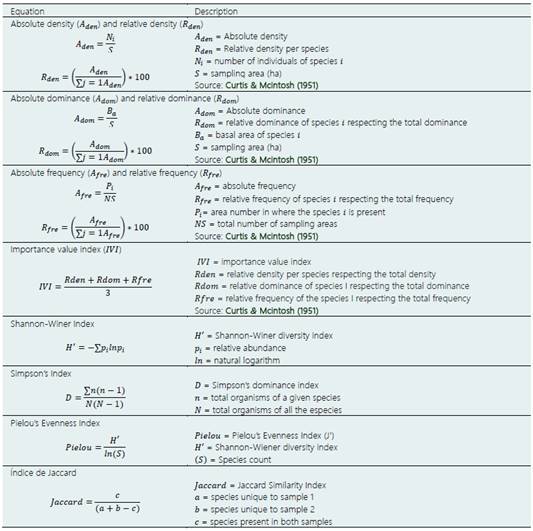
A visualization of the similarity analysis was generated with a hierarchical cluster analysis. We conducted a discriminant analysis of principal components (DAPC) to confirm the similarity between the locations. This multi-variable method was used in order to represent the CAFSs evaluated in a two-dimensional graph that allows for minimizing intra-variation and maximizing inter-population variation. The analyzes were computed with the Betapart package (Baselga et al., 2022) and the Adegenet toolkit in R v. 4.2.0 (Jombart, 2008).
2.4.4 AFSs age-based diversity
We grouped the CAFSs according to the age of the establishment. Then we estimated the diversity from the number of species and abundances with the Shannon, Pielou, and Simpson indices using the Vegan package (Oksanen et al., 2022). In addition, alpha diversity variables were compared between ages by analysis of variance (ANOVAs).
3. Results and discussion
3.1 Botanical Composition of the Cocoa Agroforestry Systems (CAFSs)
The cocoa agroforestry systems were located within an altitudinal range of 132 masl to 500 masl. During the diversity analysis, 2,519 individual trees belonging 59 species and 34 families were identified (Table 2). Of these latter, Fabaceae (50.69%), Meliaceae (16.11%), Burseraceae (6,58 %) and Lauraceae (3.45%) were the most dominant families that make up the CAFSs of the area under study. As these four families represent 76.83% of the total number of individuals, the remaining 23.17% of the total inventory belonged to 30 families.
Table 2 Importance Value Index of tree species in cocoa agroforestry systems in Alta Verapaz, Guatemala
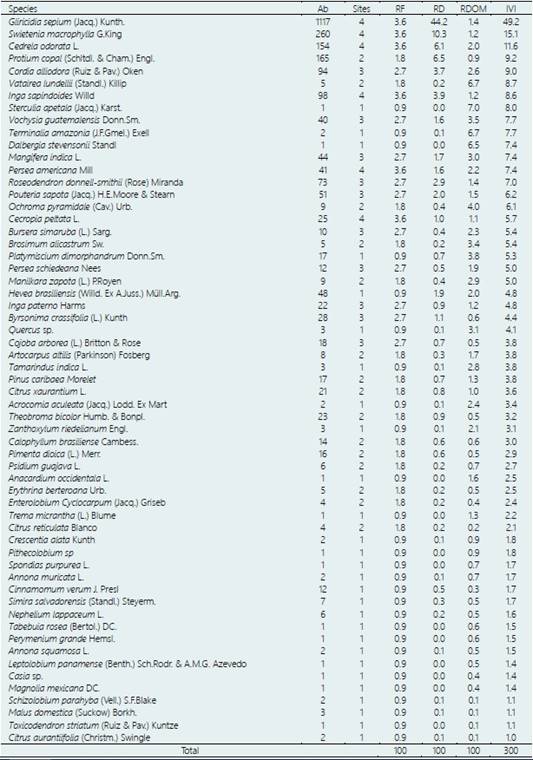
Ab= abundance, RA=Relative Abundance (%), RD= Relative Density (%), RDOM= relative dominance, IVI= Importance Value Index.
The species with the largest number of individuals from the total sampled sites were G. sepium (1,117 individuals), S. macrophylla (260), C.odorata (154), P. copal (165), and, C. alliodora (94); representing 71.05% of inventoried trees. The 59 tree species and 34 families registered in this study coincide with the data of species identified by Matey et al. (2013), Sánchez Gutiérrez et al. (2016) and Suatune et al. (2003) in multi-strata agroforestry systems in Nicaragua, Mexico and Costa Rica respectively. In other studies, the number of identified tree species has been greater, as in the case of Navarro-Garza et al. (2012), where 81 species and 34 families were identified in the analysis of diversity of useful species in AFSs in the Costa Chica region of Guerrero, Mexico. The richness and diversity of species associated with CAFSs in this case, is superior to the data registered in our study, because cocoa crops in Mexico are established under the geographical conditions of high-altitude evergreen rainforests which are valued for their biological diversity, while the CAFSs evaluated in Alta Verapaz, are established under remnants of secondary forests or under tree species introduced by the producers. The Q’eqchi’ indigenous communities in Alta Verapaz protect a diversity of tree species in traditional AFSs that have been fundamental for cultural and economic development. The resource management within these productive units responds to a series of factors such as cultural diversity, productive history, geographical location of farms and, the actions of organizations and agencies working in rural development in the area. These factors directly affect the tree richness and diversity found. However, different authors agree that the variability of species used as shade-trees in CAFS is influenced by production objective and the interest of the producer in diversifying their income so as not to depend solely on a single specific product (Salgado-Mora et al., 2007; Sánchez Gutiérrez et al., 2016).
3.2 Vegetation structure, vertical and horizontal stratification
The cocoa plantations were found to be between 3 and 30 years of age. The mean height of inventoried trees in the CAFSs is 10.9 m, ranging from 2 m to 32 m (Figure 2A). 81.65% of the total trees had a height less than 15 m. The average DBH was 18.2 cm, varying 3 to 90 cm. 58.79% of the trees recorded in the CAFSs are concentrated in the second diametric class (10-20 cm), indicating a preference for maintaining rapidly growing trees that serve more than one purpose in the system (Figure 2B ).
The tree density varies from 122 to 185 trees ha-1 which correspond to 8 and 25 years old respectively (Table 3). Shade-tree species in cocoa parcels are propagated by means of reforestation or species enrichment methods, in addition to organic dispersion of plants and seeds. The total number of inventoried shade trees (2,519 individuals) occupied a total basal area of 80.49 m2ha-1 (8.05 ha-1). The low stratum (2-8 m) encompasses 30 % of the individuals, while the middle stratum (9-24 m) has 69 % of the total inventoried trees, dominated by timber species and cultural value trees. The high strata (25-35 m), concentrates 1% of individuals and is represented by timber species of commercial value in the local context, such as S. macrophylla and C. odorata. The undergrowth was dominated by essential agricultural species for subsistence (Capsicum annuum L, Carludovica palmata Ruiz & Pav., Chamaidorea tepejilote Liebm., Manihot esculenta Crantz, among others). Our data showed that the density and diversity of forest species identified in the CAFSs under the conditions of the study area (151 trees ha-1), was similar to the density reported in Nicaragua (145 trees ha-1), Costa Rica (148 trees ha-1) and Ecuador (169 trees ha-1) (Jadán et al., 2016; Matey et al., 2013; Suatune et al., 2003). These data confirm cocoa growers’ preference for conserving a diversity of trees in productive systems for household subsistence and family welfare. Several studies have determined that AFS in Guatemala provide greater benefits for families compared to conven tional agricultural systems (Haggar et al., 2019; Ruiz Solsol et al., 2014; Sibelet et al., 2019).

Figure 2 Analysis of the principal biometric variables. A) Classification of strata corresponding to the height of the shade-trees inventoried in the cocoa AFSs of Alta Verapaz, Guatemala (left) and, B) Classification of the diameters of the same shade-trees (right).
In the present study, the results indicate that the uses of shade trees for cocoa producing families are firewood (30 species), construction (25), food (19), medicine (18), forage (13) living fences (7) and other cultural uses (4). Méndez et al. (2013) agrees with the importance of diversity in the livelihoods of small producers and indicates the following uses: food, firewood, medicinal use, construction, shadow, etc. This is also consistent with different studies throughout the American continent, such is the case of Mexico (Chablé-Pascual et al., 2015) and Peru (Vebrova et al., 2014), as well as the study conducted by Kaba et al. (2020) in Ghana, Africa, which identified the diversity and importance of uses of trees in rural communities. Each of these studies found the trees to be used most commonly for food, timber and medicine.
3.3 Structural indices
The species with the highest importance value index (IVI) in the study are: G. sepium (49.2%), S. macrophylla (15.1%), C. odorata (11.6%), P. copal (9.2%), and C. alliodora (8.99%). G. sepium and S. macrophylla were registered in all evaluated locations. P. copal is present in the CAFSs within the municipalities of Lanquín and Cahabón, while C. alliodora is present in Cobán, Cahabón and Panzós (Table 2). These species coincide with the IVI of the study conducted by Sol-Sánchez et al. (2018), in Tabasco and Zequeira-Larios et al. (2021), in Chiapas, Mexico. Nicli et al. (2019), states that these species are of high importance in Alta Verapaz for the balance of nutrients in ecosystems, such is the case of G. sepium, a forest species which provides nutrients in the form of abundant biomass to the benefit of the agroforestry systems (Avendaño-Arrazate et al., 2021). In addition, trees in these systems are valued primarily for their timber potential and for the opportunities they offer to diversify household incomes and livelihoods. The IVI of the species in our study differs from another study in Tabasco, Mexico conducted by Salvador-Morales et al. (2019), the species with the greatest IVI in that study are: Diphysa robinioides Benth, Erythrina americana Mill, Colubrin arborescens (Mill.) Sarg. The use of species by producers will depend on the agroecological conditions and the objective in the AFS.
3.4 Species richness and diversity
The species richness of trees in the cocoa AFSs within Alta Verapaz is between 4 and 64 species ha-1. The specific richness across the municipalities was determined between 11 and 39 species. Cahabón showed the greatest species richness; Lanquín and Panzós were equivalent in number of species (31), while Cobán exhibited the lowest species record.
According to Shannon's diversity index, the CAFSs evaluated in the municipality of Panzós were the ones that registered the greatest diversity with respect to the relative abundance of the species (H´=2.17), followed by the municipalities of Cahabón (H´=2.13) and Lanquín (H´=2.11), the AFSs of the municipality of Cobán presented the lowest diversity (H´=1.56) (Figure 3). In contrast, the Pielou index revealed that Cobán is the site with the highest value of evenness (J'=0.65), since the species occur amongst themselves with relatively similar abundance. According to this same index, Cahabón shows less species evenness (J'= 0.58) as the species registered greater variability in abundance between the plots (G. sepium) (Figure 3). Simpson's dominance index (D) indicates that there is a greater degree of species dominance in the municipality of Lanquín (D=0.77), followed by Panzós, Cahabón and Cobán (D=0.75, 0.72, and 0.69 respectively) (Figure 3).
In Cobán, growers appear to favor complementing cocoa production with tree species commercially important for lumber, because producers manage their CAFSs under forest incentives granted by the National Forest Institute. On the contrary, in LanquÍn, Cahabón and Panzós, where -while the income from commercial products and byproducts of the agroforestry systems are important- the farmers favor to enrich the shade-canopy through the incorporation of multipurpose trees that contribute to the sustainability of the system and family sustenance. In this sense, high diversity gives the basis to satisfy of the largest number of the needs of a family or household.
Table 3 Dendrological variables and number of families and species registered in cocoa AFSs, Alta Verapaz, Guatemala

A greater vegetation diversity in AFS is related to a greater variety of goods and services that increase the climate and market resilience of the productive systems, such as timber (firewood and lumber) and non-timber products (fruits, nuts, leaves, etc.) (Palacios & Bokelmann, 2017; Torres et al., 2015). Likewise, Martínez-Salinas et al. (2022) found that greater species diversity increases the presence of natural enemies of pests as well as plant disease vectors of agricultural crops both on the farm and in the landscape. Increased biodiversity also benefits the production of cacao and coffee through ecosystem services such as pest control and pollination (Chain-Guadarrama et al., 2021).
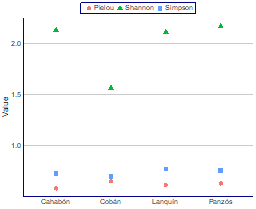
Figure 3 Comparison of the diversity indices across municipalities: Shannon-Weiner Index, Simpson Index and Pielou Evenness Index for cocoa AFS in the four municipalities of Cahabón, Cobán, Lanquín and Panzós in Alta Verapaz, Guatemala.
The seventy CAFSs were classified into seven groups based on the age of the cocoa trees. Applying the Shannon diversity index, the AFSs between 9-12 years of age showed the greatest diversity of tree species (H´ = 1.99), followed by those between 6-8 years (H´ =1.80) and 13-15 years (H´ = 1,62), while the AFSs of 16+ years exhibited the lowest Shannon index of diversity (Figure 4A). This pattern may be due to growers enriching the agroforestry systems during the first years with a variety of timber species which are then harvested at around 16 years of growth, which manifests as a decrease in the diversity index. Nonetheless, ultimately the diversity value remains greater than that reported in conventional agricultural systems (Niether et al., 2020).
This advantage highlights the potential of CAFSs to compete with monocultures in economic terms, and surpass them in terms of ecosystem services, such as adaptation to climate change, carbon capture and the creation of a variety of habitats and microclimates that support biodiversity conservation (Blaser et al., 2018).
According to the Pielou evenness index (J´) of the age groups, the 6-8-year-old AFSs revealed greater homogeneity in number of individuals by species (J’=0.76), while the 26-30-year AFSs exhibited the least evenness (J’ 0.21) (Figure 4B). This is due to a predominance of commercially valued timber species in the older AFSs while younger AFS are composed of species used mainly for firewood or construction timber.
In terms of species richness, the AFSs between 13-15 years showed the greatest richness, while those between 26-30 years registered the least variety of shade-trees (Figure 4C). These results confirms that cocoa agroforestry systems undergo a change in their botanical composition, due mainly to the harvest of wood from the year 16. Notably, the sixteen-year mark is around the time the most important timber species in the system meet the minimum required dimensions for commercialization.
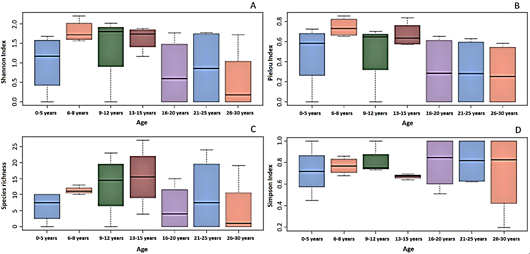
Figure 4 Relationship between the age of the cocoa AFSs in the department of Alta Verapaz with species equity (A, B), age with species richness (C) and species dominance (D).
A comparison of species richness of the CAFSs by age groups did not show significant difference (P > 0.05) with either the Shannon, Pielou or Simpson indices (Figure 4A-D), which demonstrates sustainability in terms of the rational use of tree species across time. This behavior has also been reported in studies in cocoa agroforestry systems in Ecuador and Mexico (Jadán et al., 2016; Salgado-Mora et al., 2007), reaffirming that shade-trees constitute a component that can contribute to the sustainability of this system.
3.5 Similarity Indices
The Jaccard similarity index for the CAFSs in the municipality of Cahabón, Panzós and Lanquín indicates that these tend to be marginally similar in species composition (0.57, 0.62 and 0.68) respectively; However, the most direct similarity is between the municipalities of Panzós and Cahabón sharing a total of 21 species across the sites. Natural regeneration for conservation of native species was highlighted as an important traditional management practice in these systems. Species richness was high in many CAFSs evaluated in these three localities due to low silvicultural management of the plantations, which depend on the emergence of cocoa diseases and their treatment. The AFSs in Cobán present the greatest dissimilarity in terms of species (0.83) as compared to the AFSs evaluated in the other three localities (Figure 5A). This difference is related to the establishment planning of most of the CAFSs assessed in Cobán, the management objectives and, most importantly, the silvicultural practices adopted by the owners.
The DAPC analysis revealed that some CAFSs in Cahabón, Panzós, and Cobán has a similar composition to the structure and floristic diversity recorded in Lanquín (Figure 5B and 5C). This suggests that the Lanquín CAFSs model, characterized by a more agroecological approach, is beginning to be implemented again in other cocoa-producing areas due to its high potential for conservation and sustainability management of the species.
4. Conclusions
This study is the first to demonstrate that Q'eqchi' indigenous communities play a crucial role in conserving biodiversity in cocoa agroforestry systems in Alta Verapaz. The characterization found 59 species of trees belonging to 34 families, indicating high diversity in these systems. Additionally, the biodiversity in these systems is comparable to that of other countries that recognize its importance in wildlife conservation. Therefore, it is crucial to promote training programs for local producers focused on improving silvicultural management and natural regeneration to ensure the long-term sustainability of cocoa agroforestry systems in Guatemala.














